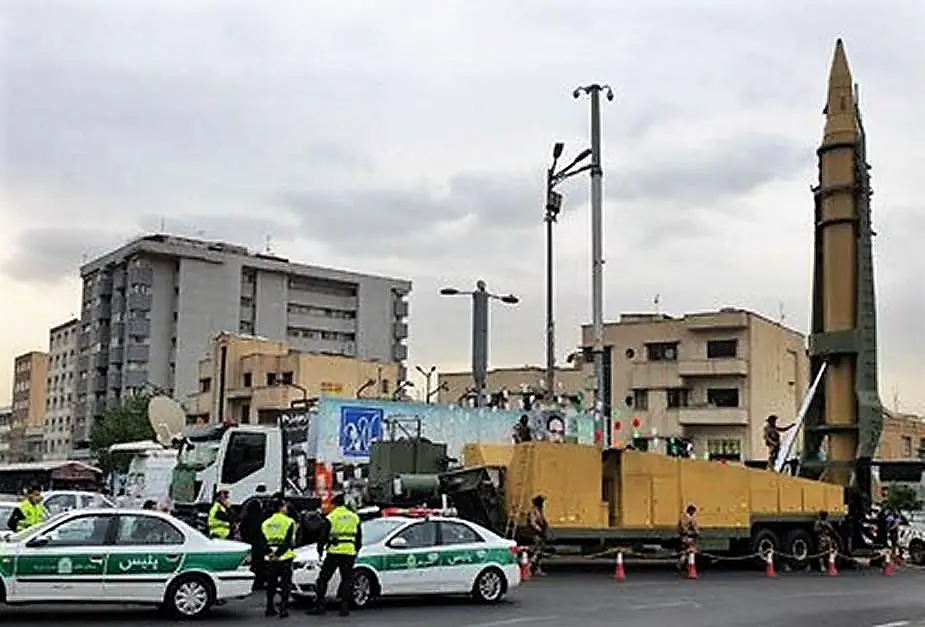Breaking news
Iran showcases latest Kheiber-Shekan and Emad-3 ballistic missiles on Quds Day.
Iran's latest ballistic missiles Kheiber-Shekan and Emad-3 were unveiled to the public on Friday, April 29, during the Quds Day march, Mehr news agency reports.
Follow Army Recognition on Google News at this link

Kheiber-Shekan (Picture source: Mehr news agency)
Iran has developed a number of variants of the original Shahab-3 missile. These have been referred to by various intelligence and media sources as the Shahab-3A, Shahab-3B, Shahab-3D, Shahab-3M, Qadr-1, Ghadr-1, and Emad. The Shahab-3 has also been used as the basis for an Iranian space program, and these rockets have been called Kavoshgar-1, IRIS, and Safir.
The IRGC said the Kheibar Shekan has a range of 1,450 km: a significant increase on the Dezful that was unveiled in February 2019 and has a claimed range of 1,000 km, which was a big improvement on previous variants, but remains unconfirmed. No figure was given for the size of the new missile's payload, as was the case with the Dezful. With a range of 1,450 km, the Kheiber-Shekan strategic missile is one of the long-range tactical missiles of the Islamic Revolutionary Guard Corps (IRGC). This all-Iranian missile has been designed and built by the scientists of the Islamic Revolutionary Guard Corps Aerospace Force. It uses solid fuel. Its weight has been reduced by one-third compared to similar models and its preparation and firing time has been reduced to one-sixth due to optimal design.

Emad-3 (Picture source: Mehr news agency)
Emad-3 long-range missile is a new generation of surface-to-surface ballistic missiles of Iran. It has been designed and built by scientists and experts of the Ministry of Defense Aerospace Industries Organization.
On October 11, 2015 Iran announced it had tested a new “long-range” missile called the Emad. The Iranian Defence Minister, Hossein Dehghan, stated that it is the first Iranian missile that can be controlled and guided until it hits its target. As it does with its other weapons, Iranian officials insist that the Emad is only a conventional weapon, and that it is not capable of carrying nuclear warheads. Regardless, the test in of itself was considered by the U.S. as a direct violation of United Nations Security Council Resolution 1929 for being a missile that is “inherently capable of delivering a nuclear weapon.”19
Analysis of the Emad points out that it is in fact not an entirely new missile, but rather it is a re-entry vehicle (RV) fitted for placement on top of a Shahab-3 or Ghadr rocket. The design and alterations to this finned RV give it increased stability, high maneuverability, and in turn a higher degree of accuracy. Jane’s reports that the Emad RV has a greater volume than previous RV’s allowing it to potentially carry heavier payloads.20 However, a detailed report on Iran’s ballistic missile programs produced by CSIS cites that the Emad has a 1,700 km range, 500 m accuracy, and a 750 kg payload capacity.21 Given its range of 1,700 km (which other reports concur with), the Emad does not qualify for a “long-range” classification, such as an IRBM or ICBM, that Dehghan might have sought. It still remains classified as an MRBM. Additionally, this payload capacity would be just under the Ghadr missile specifications (when it’s not equipped with an Emad RV), insinuating that maybe it is not as voluminous as originally thought. Having these differing reports on dimensions is not new to Iranian missiles. It’s rather common and only makes it increasingly more difficult to draw accurate conclusions about their weapons.
In January 2021, Iran claimed to have hit a naval target in the Indian Ocean over 1,800 km away using an antiship Emad missile variant during its Great Prophet 15 exercises. Iran fired multiple missiles during the exercise, including the Sejjil and Ghadr, and according to reports, multiple missiles splashed into the ocean about 160 km away from a U.S. aircraft carrier.22 Tehran’s ability to develop a long-range antiship missile still requires some skepticism though, as the reentry steering required to hit a mobile target at its proclaimed range is quite difficult.


























